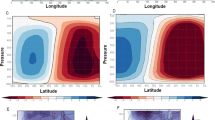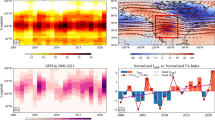Abstract
Hurricane Sandy affected the Caribbean Islands and the Northeastern United States in October 2012 and caused 233 fatalities, severe rainfalls, floods, electricity blackouts, and 75 billion U.S. dollars in damages. In this study, the synoptic and dynamical characteristics that led to the formation of the hurricane are investigated. The system was driven by the interaction between the polar jet displacement and the subtropical jet stream. In particular, Sandy was initially formed as a tropical depression system over the Caribbean Sea and the unusually warm sea drove its intensification. The interaction between a rapidly approaching trough from the northwest and the stagnant ridge over the Atlantic Ocean drove Sandy to the northeast coast of United States. To better understand the dynamical characteristics and the mechanisms that triggered Sandy, a non-hydrostatic mesoscale model has been used. Model results indicate that the surface heat fluxes and the moisture advection enhanced the convective available potential energy, increased the low-level convective instability, and finally deepened the hurricane. Moreover, the upper air conditions triggered the low-level frontogenesis and increased the asymmetry of the system which finally affected its trajectory.













Similar content being viewed by others
References
Apsan HN (2013) Resiliency and continuity: hurricane Sandy and the City University of New York. Environ Qual Manag 23(2):61–76. https://doi.org/10.1002/tqem.21361
Barnes J (2013) North Carolina’s hurricane history: updated with a decade of new storms from Isabel to Sandy. UNC Press, USA
Blake ES, Kimberlain TB, Berg RJ, Cangialosi JP, Beven II JL (2013) Tropical cyclone report: hurricane Sandy. http://www.nhc.noaa.gov/data/tcr/AL182012_Sandy.pdf. Accessed 24 Feb 2017
Cheliotis I, Varlas G, Christakos K (2017) The impact of cyclone Xaver on hydropower potential in Norway. Perspectives on atmospheric sciences. Springer, Cham, pp 175–181
Chen Y, Yau MK (2003) Asymmetric structures in a simulated landfalling hurricane. J Atmos Sci 60(18):2294–2312. https://doi.org/10.1175/1520-0469(2003)060%3c2294:ASIASL%3e2.0.CO;2
Christakos K, Varlas G, Reuder J, Katsafados P, Papadopoulos A (2014) Analysis of a low-level coastal jet off the western coast of Norway. Energy Proc 53:162–172. https://doi.org/10.1016/j.egypro.2014.07.225
Christakos K, Cheliotis I, Varlas G, Steeneveld GJ (2016) Offshore wind energy analysis of cyclone Xaver over North Europe. Energy Proc 94:37–44. https://doi.org/10.1016/j.egypro.2016.09.187
Dare RA, McBride JL (2011) The threshold sea surface temperature condition for tropical cyclogenesis. J Clim 24(17):4570–4576. https://doi.org/10.1175/MWR-D-10-05019.1
DeMaria M, Knaff JA, Connell BH (2001) A tropical cyclone genesis parameter for the tropical Atlantic. Weather Forecast 16(2):219–233. https://doi.org/10.1175/1520-0434(2001)016%3c0219:atcgpf%3e2.0.co;2
Diakakis M, Deligiannakis G, Katsetsiadou K, Lekkas E (2015) Hurricane Sandy mortality in the Caribbean and continental North America. Disaster Prev Manag 24(1):132–148. https://doi.org/10.1108/DPM-05-2014-0082
Dunkerton TJ, Montgomery MT, Wang Z (2009) Tropical cyclogenesis in a tropical wave critical layer: easterly waves. Atmos Chem Phys 9:5587–5646. https://doi.org/10.5194/acp-9-5587-2009
Frank WM, Roundy PE (2006) The role of tropical waves in tropical cyclogenesis. Mon Weather Rev 134(9):2397–2417. https://doi.org/10.1175/MWR3204.1
Galarneau TJ Jr, Davis CA, Shapiro MA (2013) Intensification of Hurricane Sandy (2012) through extratropical warm core seclusion. Mon Weather Rev 141(12):4296–4321. https://doi.org/10.1175/MWR-D-13-00181.1
Goldenberg SB, Landsea CW, Mestas-Nuñez AM, Gray WM (2001) The recent increase in Atlantic hurricane activity: causes and implications. Science 293(5529):474–479. https://doi.org/10.1126/science.1060040
Greene CH, Francis JA, Monger BC (2013) Superstorm Sandy: a series of unfortunate events. Oceanography 26(1):8–9
Halverson JB, Rabenhorst T (2013) Hurricane Sandy: the science and impacts of a superstorm. Weatherwise 66(2):14–23. https://doi.org/10.1080/00431672.2013.762838
Janjic ZI (2003) A non-hydrostatic model based on a new approach. Meteorol Atmos Phys 82:271–285. https://doi.org/10.1007/s00703-001-0587-6
Katsafados P, Papadopoulos A, Mavromatidis E, Gikas N (2011) Quantitative verification statistics of WRF predictions over the Mediterranean region. In: 12th annual WRF users’ event, 20–24 June 2011, Boulder CO, USA.
Katsafados P, Papadopoulos A, Mavromatidis E, Pytharoulis I (2011b) Numerical simulation of a deep Mediterranean storm and its sensitivity on sea surface temperature. Nat Hazards Earth Syst Sci 11:1233–1246. https://doi.org/10.5194/nhess-11-1233-2011
Katsafados P, Papadopoulos A, Korres G, Varlas G (2016) A fully coupled atmosphere–ocean wave modeling system for the Mediterranean Sea: interactions and sensitivity to the resolved scales and mechanisms. Geosci Model Dev 9(1):161–173. https://doi.org/10.5194/gmd-9-161-2016
Landsea CW (1993) A climatology of intense (or major) Atlantic hurricanes. Mon Weather Rev 121:1703–1713. https://doi.org/10.1175/1520-0493(1993)121%3c1703:ACOIMA%3e2.0.CO;2
Latif M, Keenlyside N, Bader J (2007) Tropical sea surface temperature, vertical wind shear, and hurricane development. Geophys Res Lett. https://doi.org/10.1029/2006GL027969
Lin II, Chen CH, Pun IF, Liu WT, Wu CC (2009) Warm ocean anomaly, air sea fluxes, and the rapid intensification of tropical cyclone Nargis (2008). Geophys Res Lett. https://doi.org/10.1029/2008GL035815
Magnusson L, Bidlot JR, Lang ST, Thorpe A, Wedi N, Yamaguchi M (2014) Evaluation of medium-range forecasts for hurricane Sandy. Mon Weather Rev 142(5):1962–1981. https://doi.org/10.1175/MWR-D-13-00228.1
Manganello JV, Hodges KI, Kinter JL III, Cash BA, Marx L, Jung T, Achuthavarier D, Adams JM, Altshuler EL, Huang B, Jin EK, Stan C, Towers P, Wedi N (2012) Tropical cyclone climatology in a 10-km global atmospheric GCM: toward weather-resolving climate modeling. J Clim 25(11):3867–3893. https://doi.org/10.1175/JCLI-D-11-00346.1
Molinari J, Romps DM, Vollaro D, Nguyen L (2012) CAPE in tropical cyclones. J Atmos Sci 69(8):2452–2463. https://doi.org/10.1175/JAS-D-11-0254.1
Molthan A, Jedlovec G (2013) Satellite observations monitor outages from Superstorm Sandy. Eos Trans Am Geophys Union 94(5):53–54. https://doi.org/10.1002/2013EO050001
Munsell EB, Zhang F (2014) Prediction and uncertainty of Hurricane Sandy (2012) explored through a real-time cloud-permitting ensemble analysis and forecast system assimilating airborne Doppler radar observations. J Adv Model Earth Syst 6(1):38–58. https://doi.org/10.1002/2013MS000297
NOAA (2015) Historical hurricane tracks archive. http://coast.noaa.gov/hurricanes. Accessed 24 Feb 2017
Pytharoulis I, Thorncroft C (1999) The low-level structure of African easterly waves in 1995. Mon Weather Rev 127(10):2266–2280. https://doi.org/10.1175/1520-0493(1999)127%3c2266:TLLSOA%3e2.0.CO;2
Saha S, Moorthi S, Pan H, Wu X, Wang J, Nadiga S, Tripp P, Kistler R, Woollen J, Behringer D, Liu H, Stokes D, Grumbine R, Gayno G, Wang J, Hou Y, Chuang H, Juang H, Sela J, Iredell M, Treadon R, Kleist D, Delst P, Keyser D, Derber J, Ek M, Meng J, Wei H, Yang R, Lord S, Dool V, Kumar A, Wang W, Long C, Chelliah M, Xue Y, Huang B, Schemm J, Ebisuzaki W, Lin R, Xie P, Chen M, Zhou S, Higgins W, Zou C, Liu Q, Chen Y, Han Y, Cucurull L, Reynolds R, Rutledge G, Goldberg M (2010) The NCEP climate forecast system reanalysis. Bull Am Meteorol Soc 91:1015–1057. https://doi.org/10.1175/2010BAMS3001.1
Shapiro MA, Keyser DA (1990) Fronts, jet streams, and the tropopause. US Department of Commerce, National Oceanic and Atmospheric Administration, Environmental Research Laboratories, Wave Propagation Laboratory, Silver Spring
Simpson RH, Saffir H (1974) The hurricane disaster potential scale. Weatherwise 27(8):169
Skamarock WC, Klemp JB, Dudhia J et al (2008) A description of the advanced research WRF version 3. In: Technical report TN-4751STR, NCAR
Thorncroft CD, Hoskins BJ (1994) An idealized study of African easterly waves. I: A linear view. Q J R Meteorol Soc 120(518):953–982. https://doi.org/10.1002/qj.49712051809
Trenberth KE, Fasullo J (2007) Water and energy budgets of hurricanes and implications for climate change. J Geophys Res 112:D23107. https://doi.org/10.1029/2006JD008304
Varlas G, Katsafados P, Papadopoulos A (2013) The synoptic and dynamical characteristics of the hurricane Sandy. In: 13th CEST 5–7 Sep 2013, Athens (available at paper, accessed 29 Nov 2017)
Varlas G, Katsafados P, Papadopoulos A, Korres G (2017) Implementation of a two-way coupled atmosphere–ocean wave modeling system for assessing air–sea interaction over the Mediterranean Sea. Atmos Res. https://doi.org/10.1016/j.atmosres.2017.08.019
Wu CC, Cheng HJ, Wang Y, Chou KH (2009) A numerical investigation of the eyewall evolution in a landfalling typhoon. Mon Weather Rev 137(1):21–40. https://doi.org/10.1175/2008MWR2516.1
Xie L, Yan T, Pietrafesa LJ, Morrison JM, Karl T (2005) Climatology and interannual variability of North Atlantic hurricane tracks. J Clim 18(24):5370–5381. https://doi.org/10.1175/JCLI3560.1
Xu W, Jiang H, Kang X (2014) Rainfall asymmetries of tropical cyclones prior to, during, and after making landfall in South China and Southeast United States. Atmos Res 139:18–26. https://doi.org/10.1016/j.atmosres.2013.12.015
Acknowledgements
The authors gratefully acknowledge the European Centre for Medium-Range Weather Forecasts (ECMWF) for providing the gridded analyses and surface observational data recorded by stations of World Meteorological Organization (WMO) used in the present study.
Author information
Authors and Affiliations
Corresponding author
Additional information
Responsible Editor: F. Mesinger.
Rights and permissions
About this article
Cite this article
Varlas, G., Papadopoulos, A. & Katsafados, P. An analysis of the synoptic and dynamical characteristics of hurricane Sandy (2012). Meteorol Atmos Phys 131, 443–453 (2019). https://doi.org/10.1007/s00703-017-0577-y
Received:
Accepted:
Published:
Issue Date:
DOI: https://doi.org/10.1007/s00703-017-0577-y




